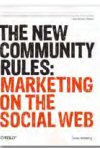My Articles & Presentations
Professional Development
Resume
Services I Provide
Testimonials
How I Work
New Clients
Disaster Preparedness
The New Community Rules: Marketing on the Social Web
Originally published in Technical Communication, Vol. 58, No. 1
Tamar Weinberg. 2009. Sebastopol, CA: O'Reilly Media. [ISBN 978-0-596- 15681-7. 345 pages, including index. US$24.99 (softcover).]
 Social media marketing can
drive traffic and relevant
links to your Web site, foster
brand awareness, entice
readers to purchase your
product or service, and help
manage your reputation,
according to The New
Community Rules: Marketing
on the Social Web. Tamar
Weinberg discusses various
forms of social media
engagement, from the better known -- such as blogging,
Twitter, and social networks (for example, Facebook) --
to the more obscure social bookmarking and niche social
news sites. She also briefly covers podcasting and other
visual media. In terms of breadth of coverage, the book
provides a useful overview of the various social media
available at this time.
Social media marketing can
drive traffic and relevant
links to your Web site, foster
brand awareness, entice
readers to purchase your
product or service, and help
manage your reputation,
according to The New
Community Rules: Marketing
on the Social Web. Tamar
Weinberg discusses various
forms of social media
engagement, from the better known -- such as blogging,
Twitter, and social networks (for example, Facebook) --
to the more obscure social bookmarking and niche social
news sites. She also briefly covers podcasting and other
visual media. In terms of breadth of coverage, the book
provides a useful overview of the various social media
available at this time.
Unlike traditional marketing, social Web marketing is a two-way street where readers can -- and will -- respond to a company's statements while also expecting their specific questions to be answered. Weinberg repeatedly stresses that the social Web consists of communities who generally frown upon overt marketing. These communities instead expect that participants contribute to discussions, answer questions, and are generally helpful to other community members. This means that more subliminal marketing emphasizing individual company employees' unique voices is needed. The book provides a number of case studies showing how such marketing has benefitted specific companies.
The New Community Rules seems geared toward companies selling to end consumers, and within these companies, to the marketing-savvy. Visually separate definitions explain many Web terms, but marketing terminology is not explained -- presumably because readers are assumed to be familiar with it. Given this target audience, the book might not be particularly helpful for technical communicators attempting to market themselves or their company.
Some statements in each chapter are footnoted, but unlike annotations in standard format, the footnotes themselves are simply URLs for specific Web pages, without any indication of what exactly the URL is pointing to. In the body text itself, sometimes very specific information on tools and sites -- including subscription pricing -- is provided. Given the speed at which both URLs and pricing change, much of that information is likely to be outdated long before the book is out of print.
Like the social media it covers, The New Community Rules is fairly chatty, at times providing excessive detail on specific tools and sites, while briefly summarizing -- or entirely omitting -- others. The chapter on social networks, for example, lists international professional social networks but omits Xing, one of the most widely used networks in continental Europe. Weinberg also frequently repeats a point, sometimes even rephrasing it in the next sentence. This repetition, as well as a number of grammatical and orthographic errors, could have been avoided by more careful copyediting and proofreading.
All in all, this is a useful overview, albeit one that could use some work.
After writing software documentation and managing an IT department, Barbara Jungwirth now translates technical documents from German to English. She owns reliable translations (www.reliable-translations.com), is on LinkedIn and Xing, and writes a blog, On Language and Translation (http://reliable-translations.blogspot.com/).